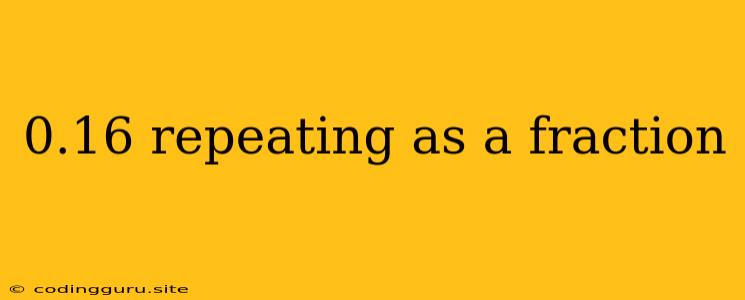How to Convert 0.16 Repeating to a Fraction
Have you ever encountered a decimal number like 0.16161616... and wondered how to express it as a fraction? This decimal, known as 0.16 repeating, represents a recurring pattern of "16" extending infinitely. Let's explore a step-by-step method to convert this repeating decimal into a fraction.
Understanding Repeating Decimals
A repeating decimal, also called a recurring decimal, is a decimal number in which a sequence of digits repeats infinitely. The repeating block is indicated by placing a bar over the repeating digits.
For example, 0.16161616... can be written as 0.16 with a bar over the "16" to signify its repeating nature.
The Conversion Process
-
Set up an equation: Let x equal the repeating decimal:
x = 0.16
-
Multiply to shift the decimal: Multiply both sides of the equation by 100 to move the decimal two places to the right:
100x = 16.16
-
Subtract the original equation: Now, subtract the original equation (x = 0.16) from the new equation (100x = 16.16):
100x = 16.16 - x = 0.16 ----------------- 99x = 16.00 -
Solve for x: Divide both sides of the equation by 99:
x = 16/99
Therefore, 0.16 repeating is equivalent to the fraction 16/99.
Simplifying the Fraction
The fraction 16/99 is already in its simplest form since there are no common factors between 16 and 99.
Example: Converting 0.3333... to a Fraction
Let's apply this method to another repeating decimal: 0.3333...
-
Set up an equation: x = 0.3333...
-
Multiply to shift the decimal: 10x = 3.3333...
-
Subtract the original equation:
10x = 3.3333... - x = 0.3333... ----------------- 9x = 3.0000... -
Solve for x: x = 3/9
-
Simplify the fraction: x = 1/3
Therefore, 0.3333... is equivalent to the fraction 1/3.
Conclusion
Converting repeating decimals to fractions might seem complex at first, but following these steps will make the process manageable. Remember, the key is to use multiplication to shift the decimal and then subtract the original equation to eliminate the repeating part. This method allows you to express repeating decimals as simplified fractions, making them easier to understand and manipulate in various mathematical calculations.
